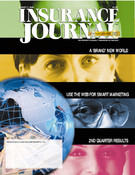California’s low-cost auto insurance program is off and running, but a major question has already come up regarding those agents who are certified to write business for the program-how willing are they to actively market the policies?
A recent Associated Press article stated that since it was launched on July 1, 2000, the two-county, low-cost auto insurance pilot program had received approximately two dozen complaints from agents. Such objections reportedly included that the policies were not profitable to write, or required an overabundance of time to set up policies for applicants who ultimately might not qualify for the coverage, or who do qualify, but will later drop the coverage after registering their vehicles.
The program was established for Los Angeles and San Francisco counties as the result of legislation signed in 1999 by Gov. Gray Davis-SB 171 (Escutia) and SB 527 (Speier). The intent of the legislation was to get more uninsured motorists insured through the provision of a low-cost auto policy. Policies offered under the new program are initially being offered at an annual rate of $450 in Los Angeles and $410 in San Francisco, and provide 10/20/3 coverage for an automobile with a maximum value of $12,000 when the lost cost policy is purchased.
While every insurer in California who writes auto liability insurance for private and passenger is required to take a certain share of the low-cost applications, there is no stipulation forcing agents to write the policies. Only agents certified with the California Automobile Assigned Risk Plan (CAARP), the appointed administrator of the program, are eligible to write the business.
Linda Yarber, chief of the California Department of Insurance (CDI) consumer communications bureau, said the CDI had not received any bona fide complaints about the program. “The kinds of inquiries we receive are, ‘How do we get into the program?’ from agents and brokers,” Yarber said. “It wasn’t complaints about the program.”
Richard Manning, regional director of CAARP, said that CAARP had received some complaints from individuals seeking an agent to write the low-cost program.
“They call in and see if they’re eligible,” Manning said. “We give them a list of certified agents. We send them a list of agents in their ZIP code area. We’ve gotten comments back from some people that they’ve tried them all and none of them want to write it or they don’t know about the program.”
However, Lorelle Kitzmiller, executive director for the American Agents Alliance, expressed the opinion that producers may be getting a bit of a bad rap on the issue. “Right now we have a very competitive marketplace here in California,” she said. “The low-cost auto policy program, it’s a bare bones coverage. The vast majority of our members say it’s inadequate coverage.”
“I think it’s unfortunate that in order for a producer to write through CAARP, they have to become a certified producer,” Kitzmiller added. “They’ve got to go through all these bells and whistles. It’s time-consuming even to start writing through CAARP. Then comes this program…I think you have to sit down and say, ‘Can I afford to do this? How can I run an agency at a commission, less my cost of operating?'”
Herb Jones, owner of CFP Insurance Services, an agency located in the Crenshaw district of Los Angeles, voiced some of the concerns he has with the program. “The major concern I’ve got is that the low-cost program is highly inadequate; it lowers the coverages from 15/30/10 down to 10/20/3,” he said, adding that in today’s market, he can get a client superior coverage for a little more, or, in some cases, even a little less, money.
Jones said another concern is that a producer could possibly be at risk E&O-wise. “[With] the individual with the 10/20/3 coverage, when the lawsuit comes about, there’s always the possibility that the attorney is going to turn to the producer and say, ‘Well, he’s the professional, he should’ve known better,'” Jones said. “The producers really have to look out for the welfare of the client on this.”
Manning reported that as of July 31, CAARP had 176 bindings made. “Of those 176 risks, we’ve assigned two insurance companies 101. We’ve rejected 12 of them, and we’ve returned-from our information- 41 of them.”
Manning said there is what he termed “a learning curve with the agents.” He also noted that the CDI will be promoting the program; for example, 400 billboards will be erected in Los Angeles with an 800 number so consumers can call CAARP to see if they are eligible for the program.
“It’s very understandable that some agents are going to be hesitant to invest the time,” said Lynn Knoff, policy manager for the Alliance of American Insurers. “You know if they’ve been burned a couple of times, they took a lot of time to work with a potential policyholder only to find out they don’t qualify-that’s always discouraging. But I would hope that California legislators and people watching this program would give it time to work before they assume this isn’t working.”
Topics California Agencies Auto
Was this article valuable?
Here are more articles you may enjoy.


 SIAA Announces Strategic Partnership With Progressive
SIAA Announces Strategic Partnership With Progressive  Good Times for US P/C Insurers May Not Last; Auto Challenges Ahead
Good Times for US P/C Insurers May Not Last; Auto Challenges Ahead  Door of Swiss Bar Where 40 Died in Fire Was Locked, Says RTS
Door of Swiss Bar Where 40 Died in Fire Was Locked, Says RTS  Experian: AI Agents Could Overtake Human Error as Major Cause of Data Breaches
Experian: AI Agents Could Overtake Human Error as Major Cause of Data Breaches 


